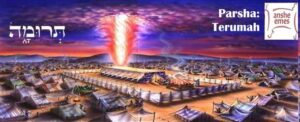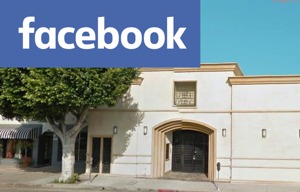I. Summary
Building The Mishkon. Hashem commanded Moshe to build a Mishkon (Sanctuary), symbolizing His presence among the Jewish people and constructed per His Divine pattern. (With the exception of the Golden Calf, the balance of Shemos is devoted to the preparations for, and the construction of, the Mishkon.) The Jews were asked to voluntarily give offerings of precious metals, fabrics, skins, wool, oil, spices, incense and precious stones. The Mishkon consisted of the Chotzeir (Outer Court) containing the altar for burnt offerings and the laver used by the Kohanim (Priests), and the Tabernacle which was divided into two chambers — (a) the Outer Chamber (the Kodesh) to which only Priests who performed sacred duties had access and which contained the Shulchan (Table of Showbread), Menorah and Mizbeiach HaKatoress (Alter of Incense); and (b) the Inner Chamber (the Kodesh Kadoshim [“Holy of Holies”]), which only the Kohen Gadol (High Priest) entered on Yom Kippur and which contained the sacred Oron (the Ark holding the 10 Commandments). The instructions respecting the construction of the utensils and the actual building needed in the Mishkon are detailed in this Parsha.
II. Divrei Torah
A. Lil’Mode U’Lilamed (Rabbi Mordechai Katz)
1. Hashem In Our Midst. Why was it necessary for the Jews to be accompanied during their wandering in the desert by the Mishkon? Doesn’t Hashem’s presence permeate the entire universe? And, why does the Torah use the words “And let them make Me a Sanctuary, and I will dwell in them” (i.e, and not “in it”)? While we may learn that Hashem’s presence is everywhere, our intellect can’t readily conceive of this; thus, Hashem provided for a specific concrete place for His presence (i.e, the Mishkon, and later the Temple). But what do we have now? The Schechinah (Divine Presence) isn’t reserved for the Mishkon and Temple — every home, synagogue and house of Jewish assembly which exhibits a Jewish manifestation through prayer, learning, mitzvos (such as family purity, kashrus, mezuzah, etc.) is itself a haven of holiness in which Hashem dwells.
2. Two Types of Charity. The Jews were asked to make 2 kinds of contributions: (a) anything the individual desired to give; and (b) a set amount which everyone — rich or poor — was obligated to give on an equal basis. This gives us insights into charity. The first contribution teaches that those who are blessed with wealth should give charity. The second contribution underscores the fact that all of us should give charity, even if our worldly possessions are few. By so doing, we recognize that all of our possessions come from Hashem and that there are always others who are more needy than we are.
3. Avoiding Hypocrisies. In constructing the Oron, Hashem commanded that there be three arks — each larger than the other, with the middle one wooden and the inner and outer ones gold. The gold both inside and outside reminds us that we must strive not to be hypocritical; that is, we must strive to be righteous both inwardly and outwardly. (Rabbi Perry Netter commented that there is one area where we should not be stopped by fear of appearing “hypocritical” — in our growth in mitzvos. One should not shy away from taking steps toward fulfilling mitzvos, such as kashrus, Shabbos, family purity because one feels hypocritical that one isn’t then ready to “go all the way”. It is certainly better to begins to take steps, even small ones, towards mitzvos observance than to not begin at all.)
B. Majesty of Man (Rabbi A. Henach Leibowitz)
1. Pure intentions/ulterior motives. “Speak to the Children of Israel, and they should take an offering for Me [Hashem]”. Why did Hashem need to emphasize “for Me”? After all, who would pass up the chance to contribute towards the Mishkon, and to seek forgiveness for the Golden Calf (according to Rashi, the Torah doesn’t follow chronological order in this instance — the Mishkon was actually assigned by Hashem as atonement for the Golden Calf)? The Torah is revealing a problem we must deal with daily — even when it can’t prevent us from performing mitzvos, our “yetzer hara” (evil inclination) can corrupt and attack even the purest intentions by creating ulterior motives for our actions; it persuades us to do mitzvos for honor and prestige, rather than wholeheartedly out of service for Hashem. If we view everything we do (e.g., our careers, money, etc.) as a means of serving Hashem, we can infuse the mundane with holiness. As Rabbi David Feinstein noted, this is why we recite in our blessing “Who has made us holy with His mitzvos” before performing a mitzvos; Hashem made us holy by giving us His mitzvos — this is our honor.
2. Economic security. The Talmud teaches that the process of making the Showbread and incense were secrets held by the families responsible for their manufacture; the Rabbis were unable to figure out their secrets or duplicate their efforts. This teaches us that whatever Hashem decrees for us as a livelihood will always be ours — no matter the state of the economy or how fierce our competition.
C. Kol Dodi on the Torah (Rabbi David Feinstein)
A wooden ark. Why was the middle ark wooden (and not gold)? Since wood is a living substance, which grows and reproduces itself (unlike gold which, while beautiful, is inert and lifeless) and is thus a more appropriate container to house the Torah. The Torah is not meant to be a display piece and sit lifelessly on a shelf; it is meant to be used and lived. A library of Jewish books which still looks new and shiny after 20 years in someone’s home has no where near the beauty of a well-used library.
D. Love Thy Neighbor (Rabbi Zelig Pliskin)
We must always try to lighten others’ burdens. Chizkuni writes that the Oron (Ark) wasn’t made entirely of gold so as to lighten the burden of the Levites who had to carry it; this reminds us that we always try to alleviate the burden of our fellow man.
E. In the Garden of the Torah (the Lubavitcher Rebbe, Rabbi Menachem M. Schneerson, z’tl)
Spreading the light of the Torah. The Temple was not intended to be an isolated corner of holiness; rather, its windows were designed to spread light outward, for the holiness of the Temple was intended to illuminate the world. Like the Temple, the radiance of the Torah is intended to be spread. We must do all we can towards this end, by opening our hearts and homes to others and showing them the beauty of Judaism.
F. Chassidic Dimension (the Lubavitcher Rebbe, Rabbi Menachem M. Schneerson, z’tl)
Minutiae: an entree to holiness. Why does the Torah go into such detail about the Mishkon, particularly since (unlike the Temple), it was never meant to be a permanent edifice? The command to build the Mishkon came soon after the Jews had experienced Hashem’s revelation at Mt. Sinai; when Hashem’s physical presence departed, a second stage in the revelation took place — a stage where it is incumbent upon man to actively draw G-dliness into the world and provide a dwelling place for Hashem in it. The Mishkon allowed the Jews to transform the physical into a dwelling place for the spiritual. The name of this Parsha — Terumah — has the dual meanings “separating” and “uplifting” — by separating material objects from their mundanity and uplifting them to holiness, a Jew is empowered by Hashem to transform the entire world into one vast Tabernacle; in such service, every step and detail is important.
G. Wellsprings of Torah (Rabbi Alexander Zusia Friedman)
1. “Take” An Offering. “And the L-rd spoke to Moshe, saying Speak to the Children of Israel, that they may take for Me an offering . . . ” Why does the Torah use the word “take,” rather than “give”? Because we aren’t in a position to “give” anything to Hashem. Everything we have belongs to Hashem. Only through the act of using our possessions to perform good deeds for Hashem’s sake do we truly acquire them, and if we then make a gift of them to Hashem it is as if we have given of our own property. (Malbim)
2. Building A Sanctuary In Your Heart. “And let them make Me a Sanctuary, that I may dwell among them.” Shouldn’t the text read, “that I may dwell within it?” The words “that I may dwell among them” refers to the Jewish people. It implies that it is the duty of each and every Jew to make a sanctuary within his or her heart, a place in which the Divine Presence may dwell. If all Jews build such a sanctuary, Hashem will dwell in the heart of each and every one of them. (Moses ben Chaim Alshekh)
H. Peninim on the Torah (Rabbi A.L. Scheinbaum)
1. The Lessons of the Keruvim. “And the Keruvim shall be spreading out their wings on high . . . with their faces one towards another.”
a. Each Jew must strive to achieve both attributes which are implied by the Keruvim. He should “spread his wings upward”, making every attempt to consecrate his whole being to Heaven. At the same time, however, it is necessary to maintain “their faces one towards another,” concerning himself with his fellow Jews’ welfare and thinking of ways to be of service to his friends during their times of need. These two behavior patterns must be integrated into the behavior patterns of a Jew. Rather than being contradictory, they compliment each other.
b. The Talmud (Bava Basra 99a) questions the disparity between two verses — the verse in our Parsha which describes the Keruvim as facing each other, and the verse in Divrei HaYamim which depicts them as facing away from each other. The Talmud explains this disparity by noting that when the Jews fulfilled Hashem’s words, their virtue was reflected by the Keruvim embracing each other as a sign of Heavenly approval. However, when they didn’t properly uphold Hashem’s mitzvos, the Keruvim faced away from each other. We may suggest that the Keruvim were not merely indicating Hashem’s displeasure, but were also portraying the underlying source of His disapproval — when Jews are loving and caring to one another, they are fulfilling Hashem’s Will. This effects a favorable response, represented by the Keruvim’s embrace. When Jews turn away from each other, each only concerned with his well-being, the source of displeasure is likewise portrayed by the Keruvim. Our relationship with others reflects our orientation with Hashem. (HaRav Yitzchak Spektor, zt’l)
2. Holding On to Spiritual Inspirations. “That they take for Me a terumah.” The Bal Shem Tov, z’tl noted that this Parsha, which contains the mitzvah of donating towards the building of the Mishkon immediately follows Parsha Mishpotim, which ends with the receiving of the Torah. He explains that the command to build the Mishkon was Hashem’s way of telling the Jews to substantively actualize their acceptance of the Torah. It wasn’t enough for them to proclaim, “We will do and we will hear,” and then return to their normal lives as if nothing had transpired. It is imperative to stimulate the potential of our statements into action. If it remains dormant, eventually it will lose its spirit and vibrance. We may apply this concept to other forms of spiritual inspiration. Often one listens to a moving speech or has a heightened spiritual experience, only to let its effects dissipate. Beyond the change one experiences at the initial encounter, one must seek to sustain the original feelings. This form of emotional response is reinforced by Torah study. One who is spiritually inspired, but doesn’t continue on to Torah study will unfortunately remain spiritually stagnant. The effort one expends in immortalizing his moments of spiritual elevation will be reflected in his personal growth and development.
3. An Offering From the Heart. “And offering from everyone whose heart motivates him to give . . . gold, silver and cooper.” Each of these metals has a different value, yet they are mentioned together and considered of equal importance, for this is an “offering of the heart”, regarding which it is stated “whether one gives more or less it is meaningless, as long as his thoughts are focused for (the honor of) Heaven.” (Berachos 5b).
I. Darash Moshe (Rav Moshe Feinstein, z’tl)
Individual Sanctity. “Like everything that I show you.” Rashi comments that this verse is to be read together with the preceding one: Make a Sanctuary for Me, like everything that I show you. If so, why does the Torah interrupt this thought with the promise: “so I may dwell among them?” The Torah wishes to show that Hashem’s explicit instructions apply only to creating this sanctity, the sanctity of the Sanctuary. But, there is also another sanctity — that which each Jew is required to bring into his heart and home by educating his children and instilling in his family the behavior and customs that the Torah holds as proper and desirable behavior. For this kind of sanctity, there are no general instructions which apply to everyone equally — each person must develop for himself ways of educating his children which are best suited to the child’s individual nature, personality and abilities. The essential point is that everything we do must be for the sake of Hashem (however that can be accomplished in a particular situation), to drawing others close to Hashem and his mitzvos.
Next week: TETZAVEH
COMING SOON: PURIM




 Visit the group and request to join.
Visit the group and request to join.
